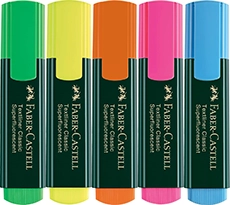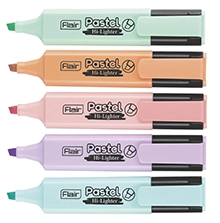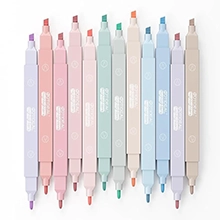How Students Can Best Use Fluorescent Marker Pens for Biology
Biology is a subject that demands extensive reading, memorization, and a deep understanding of concepts. For students, staying organized and highlighting key points are crucial steps towards academic success. Fluorescent marker pens have proven to be indispensable tools for this purpose. Below is a comprehensive guide on how these pens can be effectively utilized in the study of biology.
Enhancing Note-Taking and Organization
Highlighting Key Terms and Definitions
Using fluorescent markers to emphasize key terms, such as scientific terminologies, classifications, and definitions, can improve focus. Important terms, like “photosynthesis,” “mitosis,” or “binomial nomenclature,” can be marked to make them stand out on the page. This approach ensures easy retrieval during revision.

Best fluorescent marker pens for biology
Color-Coding for Better Structure
Different colors can be assigned for various categories or themes. For example:
- Green for plant physiology.
- Blue for human physiology.
- Pink for definitions.
- Yellow for important examples.
This system ensures a structured presentation of notes, reducing the time spent searching for information.
Creating Visual Cues
Diagrams, flowcharts, and tables are often integral to biology. Using fluorescent markers to outline or shade parts of diagrams—such as the structure of a cell or the human heart—enhances understanding. Brightly colored markers help in visually distinguishing parts for better recall.
Improving Textbook Study
Marking Vital Sections
Fluorescent markers can be used to underline or highlight critical sections in textbooks. Chapters like “Plant Kingdom” or “Cell: Structure and Function” contain dense material. By marking significant sentences, students can prioritize essential content while revising.
Creating Summary Boxes
Margins or blank spaces in textbooks can be utilized for writing brief summaries using fluorescent markers. Important points or bullet lists, when noted in bright colors, make it easier to revisit key ideas without rereading entire paragraphs.
Building Interconnections
Complex topics, such as enzyme action or hormone regulation, often require connecting multiple concepts. Drawing arrows or lines with fluorescent markers between related points can establish clarity and aid in understanding interrelations.
Aiding Revision and Recall
Making Flashcards Vibrant
Flashcards are effective tools for memorization. Fluorescent markers can be used to write headings or emphasize critical information on flashcards. For example, the name of a hormone on one side and its function on the other can be highlighted for quicker retention.
Grouping Similar Topics
While preparing for exams, topics such as “human physiology” and “plant physiology” can be grouped by using specific marker colors. This approach avoids confusion and supports systematic revision.
Revisiting Highlighted Content
The use of fluorescent markers ensures that previously highlighted content is easy to locate. During revision sessions, attention is naturally drawn to the most crucial sections, saving time and enhancing productivity.

Best fluorescent marker pens for biology
Facilitating Collaborative Learning
Sharing Notes with Peers
Group study sessions can be more effective when fluorescent markers are employed. Color-coded notes can make it simpler for peers to understand highlighted points, promoting collaborative learning.
Creating Visual Presentations
Projects, charts, and posters prepared for biology assignments can be made more engaging using fluorescent markers. For example, while presenting the life cycle of a frog or the structure of DNA, key components can be brightly colored for emphasis.
Practical Applications in Laboratory Work
Labeling Slides and Specimens
In biology practicals, fluorescent markers are useful for labeling slides and specimens. Marking observations in bright colors ensures better readability and organization.
Preparing Lab Reports
Important observations, data, and conclusions in lab reports can be highlighted to make them visually appealing. For example, results related to experiments on “respiration in plants” can be marked for clarity.

Best fluorescent marker pens for biology
Developing Exam Strategies
Highlighting Instructions in Question Papers
While answering biology exams, underlining or marking instructions in the question paper with fluorescent markers can prevent mistakes. For example, emphasizing keywords like “explain,” “draw,” or “compare” ensures that responses align with what is asked.
Structuring Answers
Using fluorescent markers to highlight headings and subheadings in long-answer questions improves readability for examiners. For instance, an answer on “photosynthesis” can be structured into subheadings like “process,” “stages,” and “importance.”
Maintaining a Long-Term Study Plan
Creating Study Timelines
Fluorescent markers are helpful for planning study schedules. Different colors can be assigned to indicate priority levels, deadlines, or progress in various topics, such as “Animal Kingdom” or “Photosynthesis in Higher Plants.”
Tracking Progress
Checklists or study planners can be designed with fluorescent markers to track completed topics. For example, a bright orange marker can denote tasks completed, while a purple marker may signify pending work.
Tips for Choosing the Right Fluorescent Markers
Brightness and Quality
Choosing high-quality markers that provide consistent brightness is essential. Low-quality markers often fade, making highlighted content difficult to read.
Non-Bleeding Ink
Markers with non-bleeding ink are preferable to avoid smudging or damaging notes and textbooks.
Variety of Colors
A set of markers with diverse colors allows for more effective categorization and visual appeal.
Comfortable Grip
Markers with a comfortable grip are ideal for prolonged use, especially during intensive study sessions.

Best fluorescent marker pens for biology
Conclusion
Fluorescent marker pens serve as valuable tools for students studying biology. Their ability to emphasize important details, organize information, and create visual cues makes them indispensable for effective learning. By incorporating these pens into daily study routines, students can enhance focus, improve recall, and achieve better academic results. Selecting the right markers and using them strategically ensures that biology becomes not only manageable but also enjoyable.